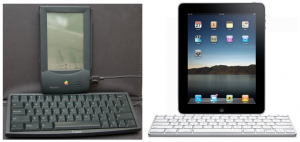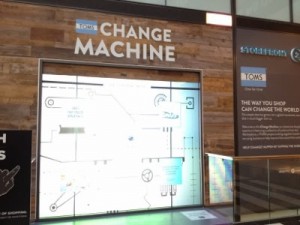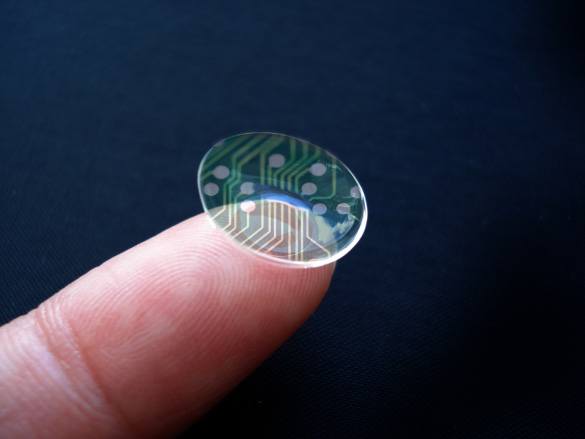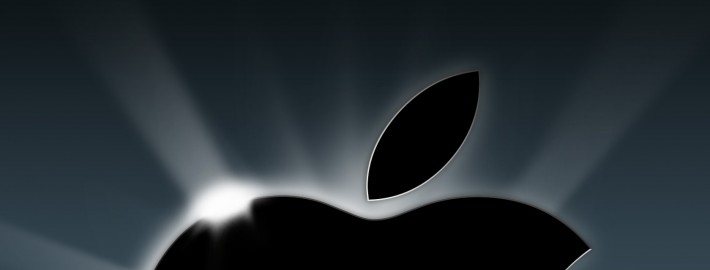
A fantastic historical review of what lead up to the iPad, and why it will succeed BIG by Cheerful Software Manifesto. We’ll just give you the big points:
On Thursday, I set my iPad up for the first time with the fold-out case and Bluetooth keyboard. And I got walloped but good by Nostalgia. Nostalgia that was chunky and green.
The heartbreaking fate of the lovable Newton is exemplar of everything that is wrong at an Apple without Steve Jobs, and why a customer reaction of “Is that it?” can be a product designer’s best friend.
TAKE A LITTLE TRIP IN MY TIME MACHINE
We can’t pretend to understand the present without first understanding the past. In this case, Apple’s past:
1998: A revolutionary, lovable Apple PDA with little squareish icons, on-screen keyboard, common icons across the bottom, single-tasking, and the best compact keyboard of the decade, complete with an ungainly but functional fold-out case. The Newton.
2010: A revolutionary, lovable Apple PDA with little squareish icons, on-screen keyboard, common icons across the bottom, single-tasking, and the best compact keyboard of the decade, complete with an ungainly but functional fold-out case. The iPad.
One an unmitigated, iconic flop, the other destined to be a success of Biblical proportions.
What a difference a decade makes.
What a difference a Steve makes.
……
…..
The problem with the Newton wasn’t any physical or technical problem. Those are easy to surmount. The problem that broke the Newton was that nobody was prepared for it.
There was no mental slot in people’s heads that the Newton could glide into.
Nothing like it had ever existed before. It was revolutionary. It was a total surprise.
THE IPAD HAS TECHNICAL PROBLEMS TOO, BUT IT DOESN’T MATTER
Today, of course, it’s an entirely different story: we’re all intimately familiar with the concept of the little computer in our pocket. We fell repeatedly for watered-down Palm handhelds which, in reality, we used rarely; we replaced them with iPhones, which we use too much.
Now the same critics who shit-canned the Newton for the wrong reasons are shit-canning the iPad for the wrong reasons.
The iPad, though, unlike the Newton, is going to win, and win on an epic scale.
Nevertheless, the shortsightedness of punditry is evergreen. Instead of praising the iPad, critics express their disappointment, because they expected more. They expected a genre buster. They expected something they’d never seen before, something beyond their imagination. Something revolutionary.
They’re disappointed that the iPad is so… well… unsurprising.
Therein, of course, lies the genius.
THE IPAD IS BARELY A SURPRISE AT ALL
The design, delivery, and timing of the iPad couldn’t be more different than the Newton. The iPad wasn’t a surprise at all. It’s the capstone in a family of devices.
There’s a cozy, pre-existing slot in people’s brains that the iPad fills quite nicely.
“Oh,” they say. “It’s a big iPhone.”
It doesn’t matter if they utter that phrase in distaste. That little sand grain of dismissal becomes the core around which will form a pearl of understanding.
“Trying to deal with email on the iPhone is tough. The screen’s too small.”
“I wish we could both work on this at the same time.”
“I’d like to sketch concepts with touch, but I keep running off the borders.”
Ding ding ding.
Steve knows, better maybe than anyone else, that you don’t just slap a product out there and hope it will succeed. You have to prepare people for it, first.
And it’s better that people misunderstand a product, at first, than not understand it at all.
THE “OF COURSE” MODEL OF INNOVATION DIFFUSION
People won’t buy a product if they can’t understand it immediately. They can’t understand it immediately if their worldview doesn’t already have a readymade place for it. And their worldview won’t have a readymade place for it, if they’ve never seen anything like it before….
Read the rest on Cheerful













